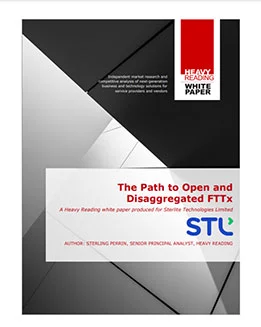Operators face continued increases in traffic, slow revenue growth, and competitive pressures to invest in and innovate for emerging cloud and 5G-related applications. As a result, they are increasingly looking to hyperscaler-led innovations, including softwaredefined networking (SDN), virtualization, and disaggregation. Due to size and complexity, fiber access networks have emerged as an area of particular interest and promise for driving lower network costs and delivering advanced services across the residential, business, and wholesale markets.
The separation of passive optical network (PON) network elements into open hardware and software components under SDN control is at the heart of the disaggregated and open architecture. This white paper begins with an overview of the drivers leading operators to evaluate disaggregation for their next-generation fixed access networks. The paper then presents the value proposition for FTTx disaggregation and programmability and details the technology, standards, and ecosystem advances that will enable mass-market adoption. Throughout the paper, Heavy Reading points to specific industry examples to illustrate industry progress in FTTx disaggregation.
FIXED BROADBAND DRIVERS/TRENDS
Global broadband speeds continue to accelerate. Omdia estimates that global average broadband speeds hit 50Mbps in 2017. As shown in Figure 1, they are forecast to exceed 270Mbps by 2024. These are global averages; in developed regions, data rates will be much higher. By 2024, for example, the average broadband speed in Hong Kong is expected to hit 460Mbps.



